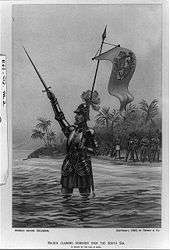South Seas
The term South Seas or South Sea commonly refers to the South Pacific. Geographically, all areas to the south of 10° north latitude belong to the South Sea.
The term South Sea is often used synonymously for Oceania and in a narrow sense for Polynesia (Polynesian Triangle). The Hawaii islands, New Zealand (Aotearoa) and the Easter Island (Rapa Nui) build the vertices. South Sea Islanders is another word for Pacific Islanders.
The South Seas Mandate was the name of the Japanese mandate over certain islands following World War I.
The “South Seas trade” was a term used in Britain in the nineteenth century to denote sealing, whaling, island trading and other commercial ship-based activities in the Pacific.
Origin
The Spanish conquistador Vasco Núñez de Balboa coined the term "South Sea" when he traveled across the Isthmus of Panama and reached the Bay of San Miguel, naming the ocean ahead Mar del Sur ("South Ocean") due to its location along the southern shore of the isthmus.

Núñez de Balboa and his soldiers tried to travel to the peak of the mountain to see the huge sea, but when they arrived at the foot of the mountain there were only 69 out of 190 soldiers left. He didn't want to share the experience of being the first to see the unknown ocean so he commanded his crew to stand still and wait. On 25 September 1513, he was the first European to see the Pacific Ocean. After looking at the ocean for some time, he told his crew to come up to share his happiness and his pride with them.
He declared the South Ocean to be property of his king, when he realized the salty water of the ocean, after he set foot into the water at the opening of the Saban river.
South Sea Paradise
In a figurative sense, the South Sea is an often idealised and distant region.
In 1773, when James Cook came to Tahiti for the second time, he was accompanied by two scientifically educated Germans Johann Reinhold Forster and Georg Forster.
- "What a morning - impossible to be described more beautifully by any poet - when we saw the isle O-Taheiti two miles ahead of us.“
The report of the discoverers determined the Europeans' picture of the South Sea for a long time. On these grounds, Joseph Banks wrote:
- "An Arcadia of which we will be king."
Louis Antoine de Bougainville's romantic travel report Voyage autour du monde as well as Georg Forster's travel description A Voyage Round the World (1777) confirmed Jean-Jacques Rousseau's image of the "noble savages". He describes the country as „jardin d’Eden“ (Garden of Eden), which provided his residents with everything required to live. He saw the islanders as pure humans not yet poisoned by civilization. The report Voyage autour du monde inspired Denis Diderot to write his essay Supplément au voyage de Bougainville, a plea for sexual freedom.
Paul Gauguin, a French artist, contributed to this picture as well. His pictures do not resemble reality, but the exotic paradise he envisioned.
Even the German writer Erich Scheurmann benefited from these desires, which can be seen in his fictional travel reports of a South Sea chief. The travel reports were published between 1915 and 1920 under the title The Papalagi. Fifty years after the book was published it became a cult book and more than 1.7 million copies were sold in the German language only.
